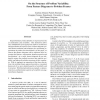Free Online Productivity Tools
i2Speak
i2Symbol
i2OCR
iTex2Img
iWeb2Print
iWeb2Shot
i2Type
iPdf2Split
iPdf2Merge
i2Bopomofo
i2Arabic
i2Style
i2Image
i2PDF
iLatex2Rtf
Sci2ools
VAMOS
2007
Springer
2007
Springer
On the Structure of Problem Variability: From Feature Diagrams to Problem Frames
Requirements for product families are expressed in terms of commonality and variability. This distinction allows early identification of an appropriate software architecture and opportunities for software reuse. Feature diagrams provide intuitive notations and techniques for representing requirements in product line development. In this paper, we observe that feature diagrams tend to obfuscate three important descriptions: requirements, domain properties and specifications. As a result, feature diagrams do not adequately capture the problem structures that underlie variability, and inform the solution structures of their complexity. With its emphasis on separation of the three descriptions, the problem frames approach provides a conceptual framework for a more detailed analysis of variability and its structure. With illustrations from an example, we demonstrate how problem frames analysis of variability can augment feature diagrams.
| Added | 09 Jun 2010 |
| Updated | 09 Jun 2010 |
| Type | Conference |
| Year | 2007 |
| Where | VAMOS |
| Authors | Andreas Classen, Patrick Heymans, Robin C. Laney, Bashar Nuseibeh, Thein Than Tun |
Comments (0)

